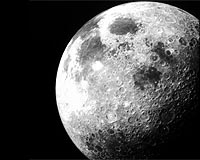 |
Washington (AFP) Nov 14, 2009 The dramatic revelation of a "significant amount" of frozen water found on the moon has been hailed by the jubilent US space agency as heralding a giant leap forward in space exploration. "The discovery opens a new chapter in our understanding of the moon," NASA said after the startling find was announced Friday, as ecstatic scientists celebrated the landmark revelation. Preliminary data, uncovered after NASA sent two spacecraft crashing into the lunar surface last month, indicated the discovery of some two-dozen gallons of water in a permanently shadowed lunar crater. "Yes indeed we found water and we did not find only a little bit but a significant amount," said Anthony Colaprete, project scientist and principal investigator for the 79-million-dollar LCROSS mission. "In the 20- to 30-meter (66- to 100-foot) crater we found maybe about a dozen, at least, two-gallon buckets of water. This is an initial result," Colaprete told reporters. Peter Schultz, professor of geological sciences at Brown University and a co-investigator on the LCROSS mission, expressed hope that more water could be found. "What's really exciting is we've only hit one spot," Schultz said. "It's kind of like when you're drilling for oil. Once you find it one place, there's a greater chance you'll find more nearby." One rocket slammed into the Cabeus crater, near the lunar southern pole, at around 5,600 miles (9,000 kilometers) per hour. The rocket was followed four minutes later by a spacecraft equipped with cameras to record the initial impact, which sent a huge plume of material billowing up from the bottom of the crater, untouched by sunlight for billions of years. "Multiple lines of evidence show water was present in both the high angle vapor plume and the ejecta curtain created by the LCROSS Centaur impact," Colaprete said. The water particles are most likely locked up as frozen particles, with temperatures in the crater estimated at a chilly minus 382 degrees Fahrenheit (230 degrees Celsius). Scientists had previously theorized that, except for the possibility of ice at the bottom of craters, the moon was totally dry. The discovery "is painting a new image of the moon," said Gregory Deloy of the University of California, hailing it as "an extraordinary discovery." He theorized that "one of the possible source of water is a comet." "The full understanding of the LCROSS data may take some time. The data is that rich," Colaprete cautioned. "Along with the water in Cabeus, there are hints of other intriguing substances. The permanently shadowed regions of the moon are truly cold traps, collecting and preserving material over billions of years." Colaprete said any lunar water would have to be extracted and purified before it could be used for drinking. "There's methanol in there. I wouldn't drink it. You'd go blind," he said. "If you could clean it, it would be drinkable water," he added. Only 12 men, all Americans, have ever walked on the moon, and the last to set foot there were in 1972, at the end of the Apollo missions. But NASA's ambitious plans to put US astronauts back on the moon by 2020 to establish manned lunar bases for further exploration to Mars under the Constellation project are increasingly in doubt. NASA's budget is currently too small to pay for Constellation's Orion capsule, a more advanced and spacious version of the Apollo lunar module, as well as the Ares I and Ares V launchers needed to put the craft in orbit. A key review panel appointed by President Barack Obama said existing budgets are not large enough to fund a return mission before 2020. Share This Article With Planet Earth
Related Links Mars News and Information at MarsDaily.com Lunar Dreams and more
 Moon holds key to solar system's secrets
Moon holds key to solar system's secretsWashington (AFP) Nov 13, 2009 The moon, which is once again the focus of an international space race, could hold the key to the birth of our planet some 4.5 billion years ago, and help unlock the oldest secrets of the universe. Forty years after American Neil Armstrong first walked on the moon, and as the United States aims to return astronauts to Earth's nearest neighbor by 2020, it remains an object of fascination and ... read more |
|
| The content herein, unless otherwise known to be public domain, are Copyright 1995-2009 - SpaceDaily. AFP and UPI Wire Stories are copyright Agence France-Presse and United Press International. ESA Portal Reports are copyright European Space Agency. All NASA sourced material is public domain. Additional copyrights may apply in whole or part to other bona fide parties. Advertising does not imply endorsement,agreement or approval of any opinions, statements or information provided by SpaceDaily on any Web page published or hosted by SpaceDaily. Privacy Statement |